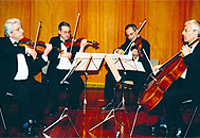genre family: Chamber Music
 The term “chamber music” generally refers to music written for a small ensemble of players and suggests an intimate approach to music-making, such as might take place at a private home, or musical salon. The expression “musica da camera” arose in the early 17th century, in contrast to the term “musica da chiesa” (church music), and referred to both vocal and instrumental music destined for performance in the courtly homes of the aristocracy. Small ensembles were fertile testing grounds for the new developments and techniques arising in the early Baroque – including basso continuo (harpsichord and bass accompaniment) and monody (melody with accompaniment), soon giving rise to the sonatas and suites that would come to dominate instrumental practice – and peak in the chamber works of Arcangelo Corelli, Antonio Vivaldi, J.S. Bach, and George Frideric Handel. By the mid-18th century, the harpsichord continuo was being replaced by the piano, and chamber music was once again a testing ground for the new galant or Classical style. The corresponding rise of the middle class opened up a large new audience for home-made music, and a whole host of chamber genres emerged – most notably, the chamber sonata (a work for violin or flute, etc. with piano accompaniment), the piano trio, and the string quartet. The latter became the quintessence of Enlightenment-era chamber music, particularly as perfected by Franz Joseph Haydn and Wolfgang Amadeus Mozart – and summarized by Goethe’s famous definition of a string quartet as “a conversation between four educated men”.
The term “chamber music” generally refers to music written for a small ensemble of players and suggests an intimate approach to music-making, such as might take place at a private home, or musical salon. The expression “musica da camera” arose in the early 17th century, in contrast to the term “musica da chiesa” (church music), and referred to both vocal and instrumental music destined for performance in the courtly homes of the aristocracy. Small ensembles were fertile testing grounds for the new developments and techniques arising in the early Baroque – including basso continuo (harpsichord and bass accompaniment) and monody (melody with accompaniment), soon giving rise to the sonatas and suites that would come to dominate instrumental practice – and peak in the chamber works of Arcangelo Corelli, Antonio Vivaldi, J.S. Bach, and George Frideric Handel. By the mid-18th century, the harpsichord continuo was being replaced by the piano, and chamber music was once again a testing ground for the new galant or Classical style. The corresponding rise of the middle class opened up a large new audience for home-made music, and a whole host of chamber genres emerged – most notably, the chamber sonata (a work for violin or flute, etc. with piano accompaniment), the piano trio, and the string quartet. The latter became the quintessence of Enlightenment-era chamber music, particularly as perfected by Franz Joseph Haydn and Wolfgang Amadeus Mozart – and summarized by Goethe’s famous definition of a string quartet as “a conversation between four educated men”.
In the 19th century, chamber music continued to grow in popularity, both as serious concert music, as well as the more lightweight fare associated with the bourgeois salon in Paris and Berlin, etc. Within serious circles, chamber music during the Romantic era became increasingly connected with the thematically dense and highly personal expression found in the chamber sonatas, piano trios, string quartets, quintets, etc. of Ludwig van Beethoven, Franz Schubert, Johannes Brahms, and Antonín Dvoràk. During the Modern era, chamber music allowed composers to exercise their reaction against the excesses of late-Romanticism, while likewise experimenting with new timbres and styles. Traditional chamber genres continued to find favor, as in the great string quartets of Béla Bartók and Dmitri Shostakovich, though many composers turned to unusual instrument combinations – such as Anton Webern’s Quartet, for clarinet, saxophone, piano and violin, Op.22 and Igor Stravinsky’s Ragtime, for 11 instruments. Chamber music is alive and well in the Contemporary era, as composers continue to gravitate to its stylistic and technical freedom, its manageable performing logistics (compared to orchestral music, for example), its endless opportunities for virtuosic writing, and above all its intimacy.

Nolan Gasser, PhD
Artistic Director













